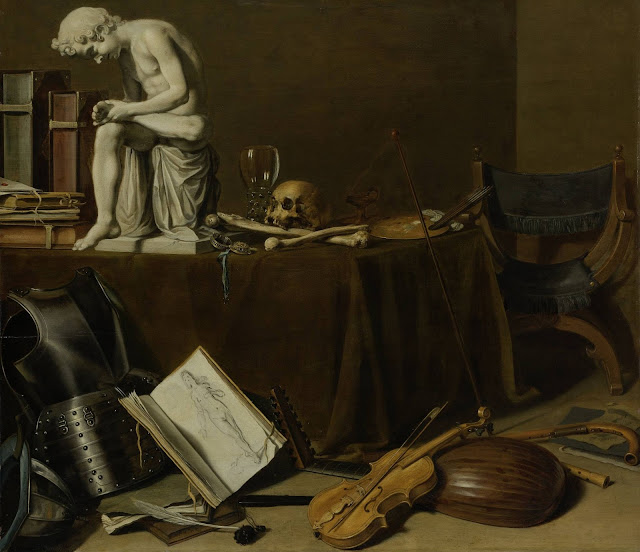 |
| Borghese Gladiator Roman marble copy of an earlier Greek work formerly in the Villa Borghese since 1811 in the Louvre |
The Borghese Gladiator (above) was discovered and restored in the early 17th century. It was by far the most admired statue displayed in the Villa Borghese until it was sold to Napoleon with many other Borghese marbles and shipped to France. "Soon after it had left for Paris a traveler commented that it was 'the last of those great perceptive statues which served Rome as canons of the art'."
 |
| Lambert-Sigisbert Michel Borghese Gladiator 1751 copy - marble statuette Los Angeles County Museum of Art |
 |
| Maria Brooks Borghese Gladiator 1872 drawing Victoria & Albert Museum |
 |
| Nicolas Dorigny Borghese Gladiator ca. 1704 etching, engraving Philadelphia Museum of Art |
 |
| Nicolas Dorigny Borghese Gladiator ca. 1704 etching, engraving Philadelphia Museum of Art |
 |
| Jan de Bisschop Borghese Gladiator 17th century wash drawing Victoria & Albert Museum |
 |
| Raphael Morghen Borghese Gladiator late 18th century etching, engraving Philadelphia Museum of Art |
 |
| Anonymous sculptor Borghese Gladiator 19th century copy - bronze statuette Philadelphia Museum of Art |
 |
| William Pether after a painting by Joseph Wright of Derby Three men at a table studying a statuette of the Borghese Gladiator by candlelight 1769 mezzotint British Museum |
 |
| Borghese Gladiator (on plinth, at center) ca. 1850 Museum of Antiquities at the Louvre from an album of photographs collected and arranged by Prince Albert Royal Collection, Great Britain |
Copies abounded both as educational tools and as garden ornaments. But the fall, when it came, was more ruthless and absolute than that of the Apollo Belvedere. Nineteenth-century art-lovers were dismayed to learn, in the first place, that this figure could never have been intended as a gladiator, and yet more dismayed that scholars could not agree to supply a new identity. Haskell and Penny in Taste and the Antique trace how the ecstatic commentary of earlier centuries was forthwith transformed to the cold modern assessment of "the harsh and unappealing character" of the work, with its "extraordinary hard, dry musculature." This formerly famous statue was also sometimes called Discobolus ; Fighting Gladiator ; Hector ; Héros Combattant ; Borghese Warrior.
 |
| Hubert le Sueur Spinario 1636-37 bronze copy cast for Charles I Royal Collection, Great Britain |
 |
| Hubert Le Sueur Spinario 1636-37 bronze copy cast for Charles I Royal Collection, Great Britain |
"In 1631 the sculptor in bronze Hubert Le Sueur (ca. 1580-1658/68) was employed by Charles I to travel to Italy, and to bring 'from thence the moulds and patterns of certain figures and antiques there'. Following the king's execution in 1649, two of the many bronze casts that Le Sueur had made for Charles I were specifically recorded in the inventory of the sale of the king's goods as being garden sculptures: these were 'The Gladiator in brass with the Marble / pedestall standing in ye garden' and 'Ye boy or pick Thorne in brass in ye garden'. The Borghese Gladiator, taken after a model of an antique sculpture in the Villa Borghese in Rome, must have been created in 1629-30, when its pedestal was prepared for the Privy Garden at St. James's Palace. The bronze figure of a boy removing a thorn from his foot, known as the Spinario, was created for Queen Henrietta Maria's garden at Somerset House in 1636-37."
– text adapted from Painting Paradise: The Art of the Garden, London, 2015
 |
| Anonymous sculptor Spinario ca. 1475-1500 adaptation - ivory statuette Rijksmuseum |
 |
| Pieter Claesz Vanitas still life with Spinario 1628 oil on panel Rijksmuseum |
"A paradox has always characterized the reception of the Spinario. Well known since the twelfth century, it gave rise to what Leonard Barkan has called "the grand industry of Renaissance Spinarios." It was drawn (and drawn on) by artists in formidable numbers. In academic theory and criticism, however, it was pointedly ignored. The Spinario may be irresistibly charming and formally intriguing, but it does not have a thema nobile, pulchrum [noble and beautiful subject], and could not be canonized in theoretical discourse."
– from The Language of the Muses by Miranda Marvin (Getty Publications, 2008)
 |
| Jacob van der Kool Spinario ca. 1725-40 adaptation - porcelain statuette Rijksmuseum |
The Spinario (in its many incarnations) went by many other names – Absalom ; Corydon ; Il Fedele ; Cneius Martius ; Nudo all spina ; Pastorello ; Cneius Pecoranus ; Pickthorne ; Priapus ; Slave removing a thorn from his foot ; Jeune Vainquer à la course.